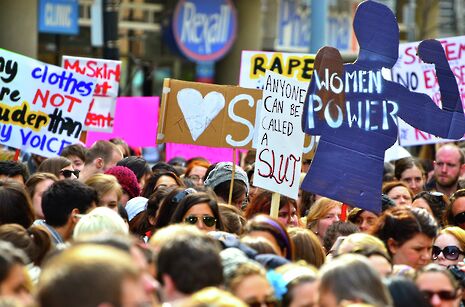Can you watch porn and be a feminist?
Violent pornography reverses the monumental strides feminism has made in the last 100 years in the click of a button, says Holly Platt-Higgins

The concept of pornography, the exhibition of sexual activity to stimulate erotic rather than aesthetic feeling, is not one I disagree with. In fact, I would strongly advocate that, as people, we have a right to explore pornography and sexuality in various mediums including film, literature, paintings, print etc.
The concept of sex has, for centuries, been oppressed within society. Even now, in the modern age, sex is still imbued with a slightly Victorian sense of taboo. Being a feminist doesn’t prevent me from being able to enjoy and engage with various types and aspects of porn. However, being a feminist means I fundamentally disagree with the frequent degrading projections of women within porn, which later contribute to a validation and encouragement of rape culture.
Obviously, women watch and engage with porn, but most porn is currently produced by men for, primarily, other men to consume. There is, then, a conscious engagement in the porn industry with male desire and wish-fulfilment. It is not here that a feminist concern with porn arises, but rather, in porn’s simultaneous disregard of female desire, which results in women being objectified.
A lot of porn is produced so that men can easily project themselves into the scenes being presented. Often, camera angles will ensure that women are totally displayed, making frequent eye-contact with the camera and producing, frankly, unrealistically parrot-like noises. Contrastingly, men will constantly have their faces removed from the shot and only offer muffled derogatory encouragement to avoid disturbing the male viewer and prevent threats of homoeroticism.
Porn creates concerns about: body image, unrealistic expectations, intimidation of the not-yet-sexually-active, accessibility (as people are being introduced to explicit content at a very young age) and, importantly, the promotion of rape culture. Porn habitually demonstrates environments where one person is no longer equal to another within a sexual act: the act is now being done to or for another person, rather than with them. The lack of equality within the images being presented to very impressionable young minds is one where sex exists within a damaging sense of hierarchy, and is frequently performed as an act devoid of consent. If your first relationship with sex is one that doesn’t require consent, then surely this sets a dangerous precedent for your future relationships.
When categories like ‘slave’, ‘punishment’ and ‘brutal’, which are pretty self-explanatory in their depiction of women in relation to sex, are readily available to anyone willing to make a few clicks on the internet, how surprising is it that approximately 85,000 women and 12,000 men get raped each year in England and Wales? Porn which encourages unregulated sexual violence towards anyone cannot conceivably be beneficial for the society we’re looking to develop and raise our children in. It is in this unapologetic, almost self-congratulating, misogyny that a dichotomy between feminism and porn takes root. Porn and feminism are not mutually exclusive, but porn that depends upon the exclusion of women, as human beings, is intrinsically opposed to the core feminist aim: that men and women should be able to operate as equals in society.
Despite constant reproach, porn has prevailed and proliferated because sexual exploration deserves a place within society, but equally, people have an obligation to be critical consumers. Is the content you’re viewing detrimental to wider society? Is it appropriate to introduce impressionable minds to sex outside the realms of consent? By engaging with sexually violent content, are you validating its place within our culture?
Being a feminist doesn’t exclude you from being able to enjoy porn but types of porn fundamentally exclude feminists
 News / Fitz students face ‘massive invasion of privacy’ over messy rooms23 April 2024
News / Fitz students face ‘massive invasion of privacy’ over messy rooms23 April 2024 News / Climate activists smash windows of Cambridge Energy Institute22 April 2024
News / Climate activists smash windows of Cambridge Energy Institute22 April 2024 News / Copycat don caught again19 April 2024
News / Copycat don caught again19 April 2024 News / Emmanuel College cuts ties with ‘race-realist’ fellow19 April 2024
News / Emmanuel College cuts ties with ‘race-realist’ fellow19 April 2024 Comment / Does Lucy Cavendish need a billionaire bailout?22 April 2024
Comment / Does Lucy Cavendish need a billionaire bailout?22 April 2024





